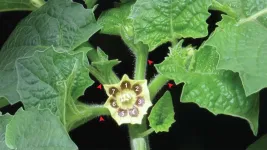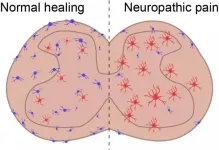(Press-News.org) Brain cells called astrocytes derived from the induced pluripotent stem cells of patients with bipolar disorder offer suboptimal support for neuronal activity. In a paper appearing March 4th in the journal Stem Cell Reports, researchers show that this malfunction can be traced to an inflammation-promoting molecule called interleukin-6 (IL-6), which is secreted by astrocytes. The results highlight the potential role of astrocyte-mediated inflammatory signaling in the psychiatric disease, although further investigation is needed.
"Our findings suggest that IL-6 may contribute to defects associated with bipolar disorder, opening new avenues for clinical intervention," says co-senior study author Fred Gage of the Salk Institute for Biological Studies.
Approximately 1-3% of individuals suffer from bipolar disorder, which is characterized by recurrent mood states ranging from high energy and elation, known as mania, to low energy and depressive episodes. Several lines of evidence suggest a link between imbalanced inflammatory signaling and bipolar disorder. For example, these patients show signs of chronic inflammation and have a higher prevalence of inflammation-related conditions such as cardiovascular disease, diabetes, and metabolic syndrome. Moreover, they have higher concentrations of circulating pro-inflammatory cytokines such as IL-1β and IL-6, particularly during manic episodes.
"While mild inflammation can be beneficial for many neural processes, the overproduction of IL-6 may worsen the symptoms of bipolar disorder and may be an important therapeutic target," says co-senior study author Maria Carolina Marchetto of the Salk Institute for Biological Studies and the University of California, San Diego and the University of California San Diego's Department of Anthropology.
Astrocytes are known to participate in the inflammatory cascade within the brain. These cells are activated by IL-1β and other pro-inflammatory cytokines and in turn secrete cytokines that participate in the process of neuroinflammation. "Due to a growing understanding of the role of neuroinflammation in psychiatric disorders, we wondered whether altered inflammation-driven signaling in astrocytes was associated with bipolar disorder," says co-senior study author Renata Santos of Salk and the Institute of Psychiatry and Neuroscience of Paris.
The researchers previously developed a method for rapidly generating inflammation-responsive astrocytes from human induced pluripotent stem cells (iPSCs). In the new study, they compared the inflammation signatures in iPSC-derived astrocytes generated from six patients with bipolar disorder and four healthy individuals.
The response of astrocytes from patients to pro-inflammatory cytokines revealed a unique transcriptional pattern, which was characterized by higher expression of the IL-6 gene. As a result, these cells secreted more IL-6, which negatively impacted the activity of co-cultured neurons. Exposure to the culture medium of the astrocytes was sufficient to decrease neuronal activity, and this effect was partially blocked by IL-6-inactivating antibody. Moreover, blood levels of IL-6 were higher in patients compared to healthy individuals.
"These results suggest that secreted factors from astrocytes play a role in regulating neuronal activity and that, in the case of bipolar disorder, IL-6 at least in part mediated the effects of inflammation-primed astrocytes on neuronal activity," says first author Krishna Vadodaria of the Salk Institute for Biological Studies.
Moving forward, the researchers plan to further investigate the effect of IL-6 on neuronal activity. In the meantime, the findings should be interpreted with caution. The experiments may not mimic conditions of chronic inflammation associated with bipolar disorder, and the culture system did not include many cell types involved in potentially relevant immune responses. In addition, iPSC-derived astrocytes are relatively immature compared to those in the brains of bipolar patients, and there is a lack of reliable biomarkers for pinpointing exact developmental age.
"At this moment, direct extrapolation of the results to patients remains challenging," Gage says. "Despite these limitations, our findings elucidate aspects of the understudied role of astrocytes in neuroinflammation in psychiatric disorders."
INFORMATION:
This research was supported by the Robert and Mary Jane Engman Foundation, Lynn and Edward Streim, the Paul G. Allen Family Foundation, Bob and Mary Jane Engman, the Leona M. and Harry B. Helmsley Charitable Trust, Annette C. Merle-Smith, the G. Harold & Leila Y. Mathers Foundation, the National Institute of Mental Health, and the Department of Veterans Affairs.
Stem Cell Reports, Vadodaria et al.: "Altered Neuronal Support and Inflammatory Response in Bipolar Disorder Patient-Derived Astrocytes" https://www.cell.com/stem-cell-reports/fulltext/S2213-6711(21)00084-9
Stem Cell Reports, published by Cell Press for the International Society for Stem Cell Research (@ISSCR), is a monthly open-access forum communicating basic discoveries in stem cell research, in addition to translational and clinical studies. The journal focuses on shorter, single-point manuscripts that report original research with conceptual or practical advances that are of broad interest to stem cell biologists and clinicians. Visit http://www.cell.com/stem-cell-reports. To receive Cell Press media alerts, please contact press@cell.com.
New collaborative research from Northwestern University and Lund University may have people heading to their backyard instead of the store at the outset of this year's mosquito season.
Often used as an additive for cat toys and treats due to its euphoric and hallucinogenic effects on cats, catnip has also long been known for its powerful repellent action on insects, mosquitoes in particular. Recent research shows catnip compounds to be at least as effective as synthetic insect repellents such as DEET.
But until now, the mechanism that triggered insects' aversion to this common member of the mint family was unknown. In a paper ...
Existing gene drive technologies could be combined to help control the invasive grey squirrel population in the UK with little risk to other populations, according to a modelling study published in Scientific Reports.
Gene drives introduce genes into a population that have been changed to induce infertility in females, allowing for the control of population size. However, they face technical challenges, such as controlling the spread of altered genes as gene drive individuals mate with wild individuals, and the development of genetic resistance, which may render the gene drive ineffective.
To address these challenges, Nicky Faber and colleagues used computer modelling to investigate the effectiveness of a combination of three gene ...
Using theoretical models of bacterial metabolism and reproduction, scientists can predict the type of resistance that bacteria will develop when they are exposed to antibiotics. This has now been shown by an Uppsala University research team, in collaboration with colleagues in Cologne, Germany. The study is published in the journal Nature Ecology and Evolution.
In medical and pharmaceutical research, there is keen interest in finding the answer to how fast, and through which mechanisms, bacteria develop antibiotic resistance. Another goal is to understand how this resistance, in turn, affects bacterial growth and pathogenicity.
"This kind of knowledge would enable better tracking and slowing ...
Induced pluripotent stem cells (iPSC) are suitable for discovering the genes that underly complex and also rare genetic diseases. Scientists from the German Cancer Research Center (DKFZ) and the European Molecular Biology Laboratory (EMBL), together with international partners, have studied genotype-phenotype relationships in iPSCs using data from approximately one thousand donors.
Tens of thousands of tiny genetic variations (SNPs, single nucleotide polymorphisms) have been identified in the human genome that are associated with specific diseases. Many of these genetic variants are ...
A team of scientists from the University of Cologne (Germany) and the University of Uppsala (Sweden) has created a model that can describe and predict the evolution of antibiotic resistance in bacteria. Resistance to antibiotics evolves through a variety of mechanisms. A central and still unresolved question is how resistance evolution affects cell growth at different drug concentrations. The new model predicts growth rates and resistance levels of common resistant bacterial mutants at different drug doses. These predictions are confirmed by empirical growth inhibition curves and genomic data from Escherichia coli populations. ...
Over evolutionary time scales, a single gene may acquire different roles in diverging species. However, revealing the multiple hidden roles of a gene was not possible before genome editing came along. Cold Spring Harbor Laboratory (CSHL) Professor and HHMI Investigator Zach Lippman and CSHL postdoctoral fellow Anat Hendelman collaborated with Idan Efroni, HHMI International Investigator at Hebrew University Faculty of Agriculture in Israel, to uncover this mystery. They dissected the activity of a developmental gene, WOX9, in different plants and at different moments in development. Using genome editing, they found that without changing the protein produced by the gene, they ...
CHAPEL HILL, NC - One of the hallmarks of chronic pain is inflammation, and scientists at the UNC School of Medicine have discovered that anti-inflammatory cells called MRC1+ macrophages are dysfunctional in an animal model of neuropathic pain. Returning these cells to their normal state could offer a route to treating debilitating pain caused by nerve damage or a malfunctioning nervous system.
The researchers, who published their work in Neuron, found that stimulating the expression of an anti-inflammatory protein called CD163 reduced signs of neuroinflammation in the spinal cord of mice with neuropathic pain.
"Macrophages are a type of immune cell that are found in the blood and in tissues ...
What The Study Did: In this study of return-to-play cardiac testing performed on 789 professional athletes with COVID-19 infection, imaging evidence of inflammatory heart disease that resulted in restriction from play was identified in five athletes (0.6%). No adverse cardiac events occurred in the athletes who underwent cardiac screening and resumed professional sports participation.
Authors: David J. Engel, M.D., of Columbia University Irving Medical Center in New York, is the corresponding author.
To access the embargoed study: Visit our For The Media website at this link https://media.jamanetwork.com/
(doi:10.1001/jamacardio.2021.0565)
Editor's Note: The article includes conflict of ...
What The Study Did: Using reverse transcription-polymerase chain reaction testing, this study found that SARS-CoV-2 was present on the ocular surface in 52 of 91 patients with COVID-19 (57.1%). The virus may also be detected on ocular surfaces in patients with COVID-19 when the nasopharyngeal swab is negative.
Authors: Claudio Azzolini, M.D., of the University of Insubria in Varese, Italy, is the corresponding author.
To access the embargoed study: Visit our For The Media website at this link https://media.jamanetwork.com/
(doi:10.1001/jamaophthalmol.2020.5464)
Editor's ...
What The Study Did: This study of more than 526,000 procedures across 17 institutions reports a significant decrease in the use of lasers and cryotherapy, retinal detachment repairs and other vitrectomies, beginning mid-March last year and lasting at least until May.
Authors: Mark P. Breazzano, M.D., of the Wilmer Eye Institute at Johns Hopkins Hospital in Baltimore, is the corresponding author.
To access the embargoed study: Visit our For The Media website at this link https://media.jamanetwork.com/
(doi:10.1001/jamaophthalmol.2021.0036)
Editor's Note: The article includes conflict of interest and funding/support disclosures. ...


